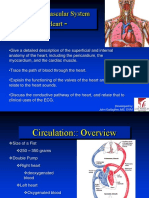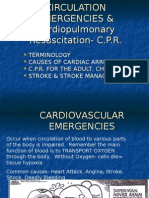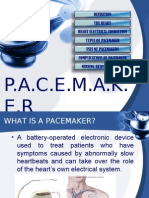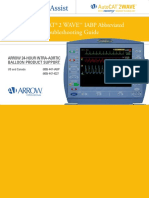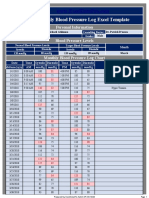Sinus Bradycardia: I. Sinus Dysrhythmias Description Management
Sinus Bradycardia: I. Sinus Dysrhythmias Description Management
Uploaded by
Margueretti Delos ReyesCopyright:
Available Formats
Sinus Bradycardia: I. Sinus Dysrhythmias Description Management
Sinus Bradycardia: I. Sinus Dysrhythmias Description Management
Uploaded by
Margueretti Delos ReyesOriginal Description:
Original Title
Copyright
Available Formats
Share this document
Did you find this document useful?
Is this content inappropriate?
Copyright:
Available Formats
Sinus Bradycardia: I. Sinus Dysrhythmias Description Management
Sinus Bradycardia: I. Sinus Dysrhythmias Description Management
Uploaded by
Margueretti Delos ReyesCopyright:
Available Formats
Delos Reyes, Maria Margueretti S.
BSN III - D3
I. SINUS DYSRHYTHMIAS DESCRIPTION MANAGEMENT
Sinus Bradycardia Occurs when the sinus node creates
an impulse at a slower-than-normal
rate. A heart rate less than 60 beats
per minute.
Atropine, 0.5 to 1.0 mg given
rapidly as an intravenous (IV)
bolus.
Pacemaker, if damage to the
hearts electrical system causes
your heart to beat too slowly.
Discontinuation of the drug if
sinus bradycardia is due to
therapeutic use of digitalis, beta-
blockers, or calcium channel
blockers.
Sinus Tachycardia Occurs when the sinus node creates
an impulse at a faster-than-normal
rate. A heart rate of more than 100
beats per minute (BPM) in adults.
Calcium channel blockers and
beta-blockers
Carotid sinus massage
Pressing gently on the eyeballs
with eyes closed.
Valsalva maneuver: holding your
nostrils closed while blowing air
through your nose.
Dive reflex: the body's response
to sudden immersion in water,
especially cold water.
Sedation
Cutting down on coffee
Cutting down on alcohol
Quitting tobacco use
Getting more rest
Sinus Arrhythmias Occurs when the sinus node creates
an impulse at an irregular rhythm;
the rate usually increases with
inspiration and decreases with
expiration.
Sinus arrhythmia does not cause
any significant hemodynamic
effect and usually is not treated.
II. ATRIAL DYSRHYTHMIAS DESCRIPTION MANAGEMENT
Atrial Flutter Occurs in the atrium and creates
impulses at an atrial rate between
250 and 400 times per minute.
Because the atrial rate is faster than
the AV node can conduct, not all
atrial impulses are conducted into
the ventricle, causing a therapeutic
block at the AV node.
If the patient is stable, diltiazem,
verapamil, beta-blockers, or
digitalis may be administered
intravenously to slow the
ventricular rate.
Flecainide, ibutilide, dofetilide,
quinidine, disopyramide, or
Amiodarone may be given to
promote conversion to sinus
rhythm
Electrical cardioversion
Atrial Fibrillation A rapid, disorganized, and
uncoordinated twitching of atrial
musculature. Occur for a very short
time (paroxysmal), or it may be
chronic. Usually associated with
advanced age, valvular heart disease,
coronary artery disease,
hypertension, cardiomyopathy,
hyperthyroidism, pulmonary disease,
acute moderate to heavy ingestion of
alcohol (holiday heart syndrome),
or the aftermath of open heart
surgery.
Cardioversion
Quinidine, ibutilide, flecainide,
dofetilide, propafenone,
procainamide
(Pronestyl), disopyramide, or
amiodarone
Intravenous adenosine
Digoxin
Pacemaker implantation
III. CONDUCTION DISTURBANCES DESCRIPTION MANAGEMENT
First-Degree Atrioventricular Block Occurs when all the atrial impulses
are conducted through the AV node
into the ventricles at a rate slower
than normal.
Discontinue medications with
potential for AV block
Admission may be indicated for
associated conditions
Pacemaker
Second-Degree Atrioventricular Block,
Type I
Occurs when all but one of the atrial
impulses are conducted through the
AV node into the ventricles. Each
atrial impulse takes a longer time for
conduction than the one before, until
one impulse is fully blocked. Because
the AV node is not depolarized by the
blocked atrial impulse, the AV node
has time to fully repolarize, so that
the next atrial impulse can be
conducted within the shortest
amount of time.
Asymptomatic patient does not
require any specific therapy in
the prehospital setting.
If the patient is symptomatic,
standard advanced cardiac life
support (ACLS)
No specific therapy is required in
the emergency department (ED)
Anti-ischemic regimen
Discontinuing digoxin, beta-
blockers, or calcium channel
blockers medications
Second-Degree Atrioventricular Block,
Type II
Occurs when only some of the atrial
impulses are conducted through the
AV node into the ventricles.
Permanent pacing
Urgent cardiology consultation
Apply transcutaneous pacing
pads
Third-Degree Atrioventricular Block
Occurs when no atrial impulse is
conducted through the AV node into
the ventricles. In third-degree heart
block, two impulses stimulate the
heart: one stimulates the ventricles
represented by the QRS complex, and
one stimulates the atria represented
by the P wave. P waves may be seen,
but the atrial electrical activity is not
conducted down into the ventricles
to cause the QRS complex, the
ventricular electrical activity. This is
Withdrawal of any potentially
aggravating or causative
medications
Pacemaker
Administration of IV fluids,
calcium, glucagons, vasopressors,
and high-dose insulin
Delos Reyes, Maria Margueretti S.
BSN III - D3
called AV dissociation.
B. Bundle Branch Blocks Occurs if there is a blockage in one of
these branches, the electrical impulse
must travel to the ventricle by a
different route. When this happens,
the rate and rhythm of your
heartbeat are not affected, but the
impulse is slowed. Your ventricle will
still contract, but it will take longer
because of the slowed impulse. This
slowed impulse causes one ventricle
to contract a fraction of a second
slower than the other.
Cardiac resynchronization
treatment (CRT)
Pacemaker
In most cases, bundle branch
block does not need
treatment.
IV. VENTRICULAR DYSRHYTHMIAS DESCRIPTION MANAGEMENT
A. Premature Ventricular Contractions
An impulse that starts in a ventricle
and is conducted through the
ventricles before the next normal
sinus impulse. PVCs can occur in
healthy people, especially with the
use of caffeine, nicotine, or alcohol.
Perform telemetry
Secure intravenous (IV) access
Administer oxygen
Complex ectopy in the setting of
myocardial ischemia or causing
hemodynamic instability should
be suppressed
Use lidocaine for patients with
myocardial ischemia.
a) Unifocal
b) Multifocal
c) Bigeminy
Trigeminy
d) Coupled PVC / Triplet
more frequent than 6 per minute
having different shapes, occur two
in a row (pair)
is a rhythm in which every other
complex is a PVC.
is a rhythm in which every third
complex is a PVC
is a rhythm in which every fourth
complex is a PVC
B. Ventricular Tachycardia
Three or more PVCs in a row,
occurring at a rate exceeding 100
beats per minute. Usually associated
with coronary artery disease and may
precede ventricular fibrillation. VT is
an emergency because the patient is
usually (although not always)
unresponsive and pulseless.
Cardioversion
Antiarrhythmic drugs
Implantable cardioverter-
defibrillator (ICD)
Catheter ablation
C. Ventricular Fibrillation
Rapid but disorganized ventricular
rhythm that causes ineffective
quivering of the ventricles. It may
also result from untreated or
unsuccessfully treated VT.
Defibrillator
CPR
Radiofrequency ablation
Surgical treatment (eg, operable
coronary artery disease)
Implantable cardioverter-
defibrillators (ICDs)
D. Asystole
Commonly called flatline, ventricular
asystole is characterized by absent
QRS complexes, although P waves
may be apparent for a short duration
in two different leads. There is no
heartbeat, no palpable pulse, and no
respiration.
Electrical defibrillation
Calcium chloride
Oxygenation and ventilation via
endotracheal intubation
Cardiopulmonary resuscitation
(CPR)
References:
1995-2014 Healthwise, Incorporated. Healthwise, Healthwise for every health decision, and the Healthwise logo are trademarks of
Healthwise, Incorporated.
Epstein AE, DiMarco JP, Ellenbogen KA, et al. ACC/AHA/HRS 2008 Guidelines for Device-Based Therapy of Cardiac Rhythm Abnormalities:
a report of the American College of Cardiology/American Heart Association Task Force on Practice Guidelines (Writing Committee to
Revise the ACC/AHA/NASPE 2002 Guideline Update for Implantation of Cardiac Pacemakers and Antiarrhythmia Devices) developed in
collaboration with the American Association for Thoracic Surgery and Society of Thoracic Surgeons. J Am Coll Cardiol. May 27 2008
http://www.heart.org/HEARTORG/Conditions/Arrhythmia/AboutArrhythmia/Tachycardia-Fast-Heart-Rate_UCM_302018_Article.jsp#
Brunner and Suddarths Textbook of Medical-Surgical Nursing, 10
th
edition.
You might also like
- ECG Interpretation Cheat SheetDocument14 pagesECG Interpretation Cheat Sheetrenet_alexandre86% (7)
- DYSRHYTHMIAS (A.k.a. Arrhythmias) Disorders in TheDocument3 pagesDYSRHYTHMIAS (A.k.a. Arrhythmias) Disorders in TheDarell M. Book100% (1)
- Pathophysiology of Congestive Heart Failure: Predisposing Factors Precipitating/Aggravating FactorsDocument1 pagePathophysiology of Congestive Heart Failure: Predisposing Factors Precipitating/Aggravating Factorsguillermojerry100% (2)
- Case Study (ACS)Document12 pagesCase Study (ACS)Kristel Joy Cabarrubias Acena100% (1)
- Arrhythmias: Sing Khien Tiong Gpst1Document34 pagesArrhythmias: Sing Khien Tiong Gpst1preethi preethaNo ratings yet
- Mitral Valve Regurgitation, A Simple Guide To The Condition, Treatment And Related ConditionsFrom EverandMitral Valve Regurgitation, A Simple Guide To The Condition, Treatment And Related ConditionsNo ratings yet
- Live Better Electrically: A Heart Rhythm Doc's Humorous Guide to ArrhythmiasFrom EverandLive Better Electrically: A Heart Rhythm Doc's Humorous Guide to ArrhythmiasNo ratings yet
- Hepatobiliary Disorders: Katrina Saludar Jimenez, R. NDocument42 pagesHepatobiliary Disorders: Katrina Saludar Jimenez, R. NKatrinaJimenezNo ratings yet
- Management of ArrhythmiasDocument4 pagesManagement of ArrhythmiasAray Al-AfiqahNo ratings yet
- Cardiac ArrestDocument54 pagesCardiac ArrestIdha FitriyaniNo ratings yet
- Ekg Panum or OsceDocument69 pagesEkg Panum or OsceGladish RindraNo ratings yet
- NSG 117 PerfusionDocument55 pagesNSG 117 PerfusionAnonymous UJEyEsNo ratings yet
- Airway and VentilationDocument36 pagesAirway and Ventilationmasoom bahaNo ratings yet
- Chest Pain.Document53 pagesChest Pain.Shimmering MoonNo ratings yet
- Cardiac II Study GuideDocument6 pagesCardiac II Study GuiderunnermnNo ratings yet
- Acute Respiratory Failure-PRINTDocument5 pagesAcute Respiratory Failure-PRINTJan SicatNo ratings yet
- Basic Ecg: A Report By: Clinical Clerk Mary Hazel TeDocument74 pagesBasic Ecg: A Report By: Clinical Clerk Mary Hazel TeHazel Arcosa100% (1)
- Liver Nursing NotesDocument7 pagesLiver Nursing NotesHeather ShantaeNo ratings yet
- Electrophysiology Study and Cardiac AblationDocument29 pagesElectrophysiology Study and Cardiac AblationBat ManNo ratings yet
- Hemorrhagic Cerebro Vascular DiseaseDocument37 pagesHemorrhagic Cerebro Vascular Diseasejbvaldez100% (1)
- Cardiovascular NotesDocument69 pagesCardiovascular NotesAnnissaLarnardNo ratings yet
- Ineffective Airway Clearance R/T Tracheobronchial ObstructionDocument23 pagesIneffective Airway Clearance R/T Tracheobronchial ObstructionGuia Rose SibayanNo ratings yet
- 533 Module 2 Fluid Electrolyte Disorders Acid Base QuizDocument7 pages533 Module 2 Fluid Electrolyte Disorders Acid Base QuizSara FNo ratings yet
- ElectrocardiogramDocument52 pagesElectrocardiogramTuong HoangManhNo ratings yet
- Chapter 19 Heart Marie BDocument29 pagesChapter 19 Heart Marie BomarNo ratings yet
- Congenital Heart DiseaseDocument45 pagesCongenital Heart DiseaseBrandedlovers OnlineshopNo ratings yet
- Arianna Mabunga BSN-3B Urinary Diversion DeffinitionDocument5 pagesArianna Mabunga BSN-3B Urinary Diversion DeffinitionArianna Jasmine Mabunga0% (1)
- Cardiac Dysrhythmias: Mrs. D. Melba Sahaya Sweety M.SC Nursing GimsarDocument60 pagesCardiac Dysrhythmias: Mrs. D. Melba Sahaya Sweety M.SC Nursing GimsarD. Melba S.S Chinna100% (1)
- Pericarditis NCLEX Review: Serous Fluid Is Between The Parietal and Visceral LayerDocument2 pagesPericarditis NCLEX Review: Serous Fluid Is Between The Parietal and Visceral LayerlhenNo ratings yet
- Congenital Heart Disease: Thoracic Conference Frank Nami, M.DDocument49 pagesCongenital Heart Disease: Thoracic Conference Frank Nami, M.DMarie CrystallineNo ratings yet
- Mechanical Ventilation: Presented By: Joahnna Marie A. Abuyan, RNDocument24 pagesMechanical Ventilation: Presented By: Joahnna Marie A. Abuyan, RNninapotNo ratings yet
- Myocardial Infraction (Mi) Acute Myocardial InfractionDocument20 pagesMyocardial Infraction (Mi) Acute Myocardial InfractionV MNo ratings yet
- MNT in Diseases of Kidney and UrinaryDocument38 pagesMNT in Diseases of Kidney and UrinaryJosephine A. Bertulfo100% (1)
- Cad PamphletDocument2 pagesCad Pamphletapi-546509005No ratings yet
- Group 4 Pathologies of The Respiratory System Report MicroDocument54 pagesGroup 4 Pathologies of The Respiratory System Report MicroNapisa NajalNo ratings yet
- Acute MiDocument45 pagesAcute Migiri00767098100% (1)
- Ventricular Fibrillation/ Pulseless Ventricular Tachycardia AlgorithmDocument2 pagesVentricular Fibrillation/ Pulseless Ventricular Tachycardia AlgorithmsafasayedNo ratings yet
- Cardiovascular Disorders: BY: Maximin A. Pomperada, RN, MANDocument65 pagesCardiovascular Disorders: BY: Maximin A. Pomperada, RN, MANRellie Castro100% (1)
- Arterial LineDocument34 pagesArterial Linepop lopNo ratings yet
- Cardiac Output MonitoringDocument25 pagesCardiac Output MonitoringmajNo ratings yet
- Cad PPTDocument81 pagesCad PPTvaishnaviNo ratings yet
- Nursing Care of Patients With Cardiac ProblemsDocument125 pagesNursing Care of Patients With Cardiac ProblemsAyeNo ratings yet
- Cardiology PDFDocument13 pagesCardiology PDFDeepthi DNo ratings yet
- ECG Interpretation: DR S J Bhosale DM, FPCC (Canada) Associate Professor Tata Memorial CentreDocument90 pagesECG Interpretation: DR S J Bhosale DM, FPCC (Canada) Associate Professor Tata Memorial Centrevaishali TayadeNo ratings yet
- Chapter (10) : Assessment of Cardiovascular SystemDocument10 pagesChapter (10) : Assessment of Cardiovascular SystemSandra GabasNo ratings yet
- Physical ExaminationDocument117 pagesPhysical Examinationsasmita nayakNo ratings yet
- Kano State College of Nursing and Midwifery: Cardiac ArrestDocument4 pagesKano State College of Nursing and Midwifery: Cardiac ArrestMuhammad Daha SanusiNo ratings yet
- Terminology Causes of Cardiac Arrest C.P.R. For The Adult, Child & Baby Stroke & Stroke ManagementDocument28 pagesTerminology Causes of Cardiac Arrest C.P.R. For The Adult, Child & Baby Stroke & Stroke Managementbusiness911No ratings yet
- Arrhythmia ReviewDocument33 pagesArrhythmia ReviewMark Hammerschmidt100% (3)
- Cme Acs 2. Stemi (Izzah)Document36 pagesCme Acs 2. Stemi (Izzah)Hakimah K. SuhaimiNo ratings yet
- Pneumonia and BronchiolitisDocument48 pagesPneumonia and Bronchiolitisshashank panwarNo ratings yet
- 1538 Exam 4 Cell Reg & GriefDocument35 pages1538 Exam 4 Cell Reg & GriefJade EdanoNo ratings yet
- Drug Overdose and ManagementDocument9 pagesDrug Overdose and ManagementKoRnflakes100% (1)
- Central Venous Pressure Monitoring: Assisting With CVP PlacementDocument3 pagesCentral Venous Pressure Monitoring: Assisting With CVP PlacementGlare RhayneNo ratings yet
- Chronic Renal Failure (Handout)Document3 pagesChronic Renal Failure (Handout)rhizzyNo ratings yet
- Care of Patients With Chest TubesDocument2 pagesCare of Patients With Chest Tubesaurezea100% (1)
- PacemakerDocument13 pagesPacemakeralainzkie100% (2)
- Cardiac Conduction System Power Point PresentationDocument30 pagesCardiac Conduction System Power Point PresentationAaya AdelNo ratings yet
- Guidelines For Management of Diabetes MellitusDocument1 pageGuidelines For Management of Diabetes MellitusthapanNo ratings yet
- Renal EmergenciesDocument11 pagesRenal EmergenciesDemuel Dee L. BertoNo ratings yet
- Diagnostic Test Purpose Normal Result Nursing ResponsibilityDocument4 pagesDiagnostic Test Purpose Normal Result Nursing Responsibilitykennethfe agron100% (1)
- Cardiac CatheterizationDocument6 pagesCardiac CatheterizationUzma KhanNo ratings yet
- A Simple Guide to Hypovolemia, Diagnosis, Treatment and Related ConditionsFrom EverandA Simple Guide to Hypovolemia, Diagnosis, Treatment and Related ConditionsNo ratings yet
- ASPIRIN Drug Study ERDocument1 pageASPIRIN Drug Study ERMargueretti Delos ReyesNo ratings yet
- Aero Soriano 1Document5 pagesAero Soriano 1Margueretti Delos ReyesNo ratings yet
- FNCPDocument11 pagesFNCPMargueretti Delos ReyesNo ratings yet
- Pathophysiology of PihDocument3 pagesPathophysiology of PihMargueretti Delos ReyesNo ratings yet
- NCP - DM, CKD, HPNDocument5 pagesNCP - DM, CKD, HPNMargueretti Delos ReyesNo ratings yet
- NCP Sa Sinus Tachycardia FinalDocument13 pagesNCP Sa Sinus Tachycardia FinalMYKRISTIE JHO MENDEZNo ratings yet
- Cardiac ArrestDocument7 pagesCardiac ArrestDiana MuañaNo ratings yet
- 8.ppm-Bangladesh PerspectiveDocument6 pages8.ppm-Bangladesh PerspectiveAshraf ChowdhuryNo ratings yet
- Antianginal DrugsDocument32 pagesAntianginal Drugssultan khabeebNo ratings yet
- 1 Emg Ecg EegDocument63 pages1 Emg Ecg EegNikhil KumarNo ratings yet
- Exercises On The Cardiovascular SystemDocument2 pagesExercises On The Cardiovascular SystemNguyễn Thị Hương Y.K53HNo ratings yet
- Heart BlocksDocument3 pagesHeart BlockslhenNo ratings yet
- Heart Lung InteractionDocument29 pagesHeart Lung InteractionKARDIOLOGI STASE RSALNo ratings yet
- Practice. After About 500 ECG's, You Be Able To Do Them Without Forgetting Major DetailsDocument5 pagesPractice. After About 500 ECG's, You Be Able To Do Them Without Forgetting Major DetailsRameezAmerNo ratings yet
- OMRON Blodd Pressure DiaryDocument2 pagesOMRON Blodd Pressure DiaryKral Liv67% (6)
- CLIX ECG Tutorial Part 3 Ischaemia EtcDocument97 pagesCLIX ECG Tutorial Part 3 Ischaemia Etcdragon66No ratings yet
- Angina PectorisDocument29 pagesAngina Pectoriszabrynah100% (1)
- SonoAce R5 Reference Manual P PDFDocument150 pagesSonoAce R5 Reference Manual P PDFNeto Infomab MedNo ratings yet
- Pediatric Heart FailureDocument31 pagesPediatric Heart Failureanwar jabariNo ratings yet
- Biology Project .Document6 pagesBiology Project .arhamhabib6969No ratings yet
- Balon Contrapulsacion Autocat 2 WaveDocument32 pagesBalon Contrapulsacion Autocat 2 WaveCarito HernandezNo ratings yet
- Heart Review Question1Document6 pagesHeart Review Question1api-236649988No ratings yet
- Laporan Kasus StemiDocument41 pagesLaporan Kasus StemiNur Aisyah Soedarmin IieychaNo ratings yet
- Monthly Blood Pressure Log Excel TemplateDocument8 pagesMonthly Blood Pressure Log Excel TemplateZeeshan Hyder Bhatti100% (1)
- Moartea Subita CardiacaDocument63 pagesMoartea Subita CardiacaAlexa whyNo ratings yet
- 02 Echo - Sys Function & Diast DysfunctionDocument31 pages02 Echo - Sys Function & Diast DysfunctionCvt RasulNo ratings yet
- 403 1376 1 SM - 2Document8 pages403 1376 1 SM - 2nier fadhillahNo ratings yet
- Kul Sistem CV Ut Prodi FarmasiDocument34 pagesKul Sistem CV Ut Prodi FarmasiMicho Zhii IntelNo ratings yet
- ECG 1 ReportDocument3 pagesECG 1 ReportJefferrson Steven Reyes Zambrano100% (1)
- 1 كتب دكتور علام باطنه General & Cardio.whiteKnightLoveDocument111 pages1 كتب دكتور علام باطنه General & Cardio.whiteKnightLoveNour ShăbanNo ratings yet
- FARMAKOGNOSI - Obat AntihipertensiDocument7 pagesFARMAKOGNOSI - Obat AntihipertensiTrianisa FebyNo ratings yet
- 12 Lead ECG Color Codes 1 - 04Document62 pages12 Lead ECG Color Codes 1 - 04ChrisieNo ratings yet
























